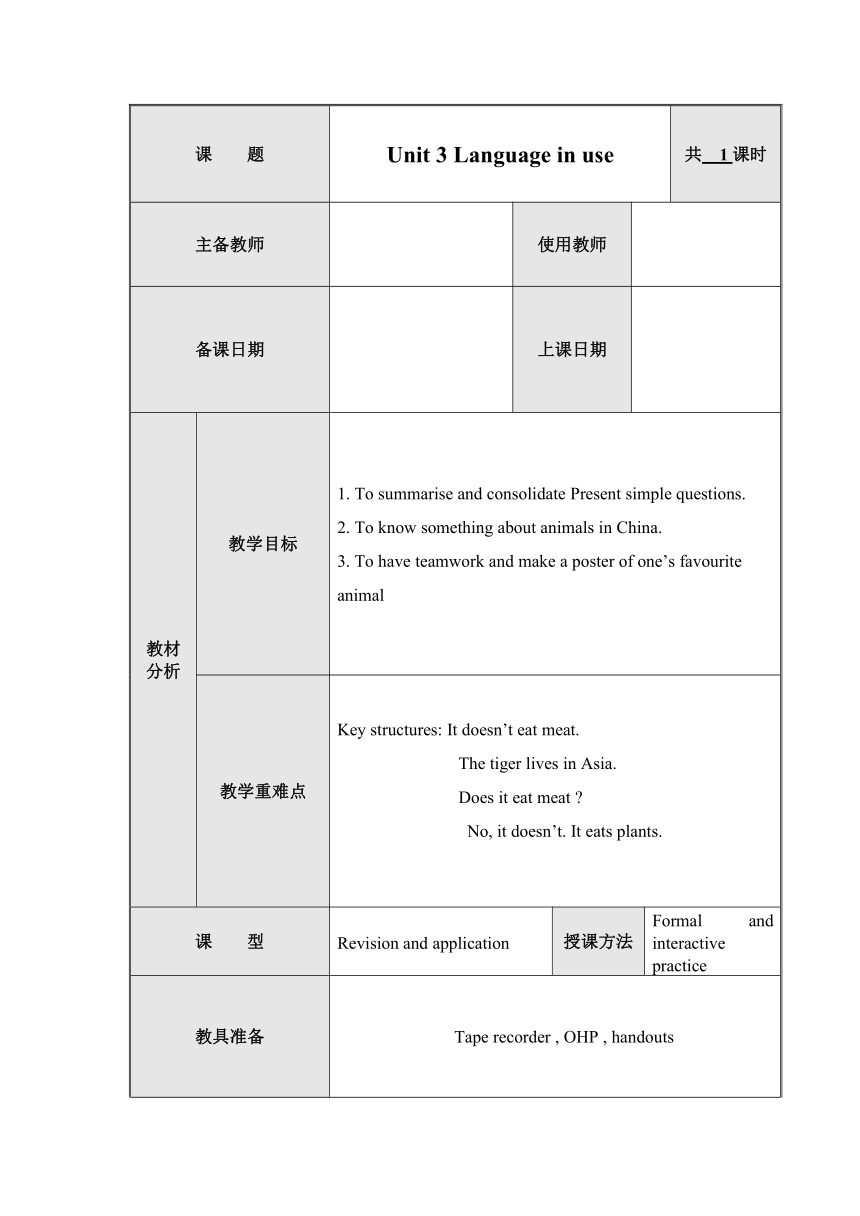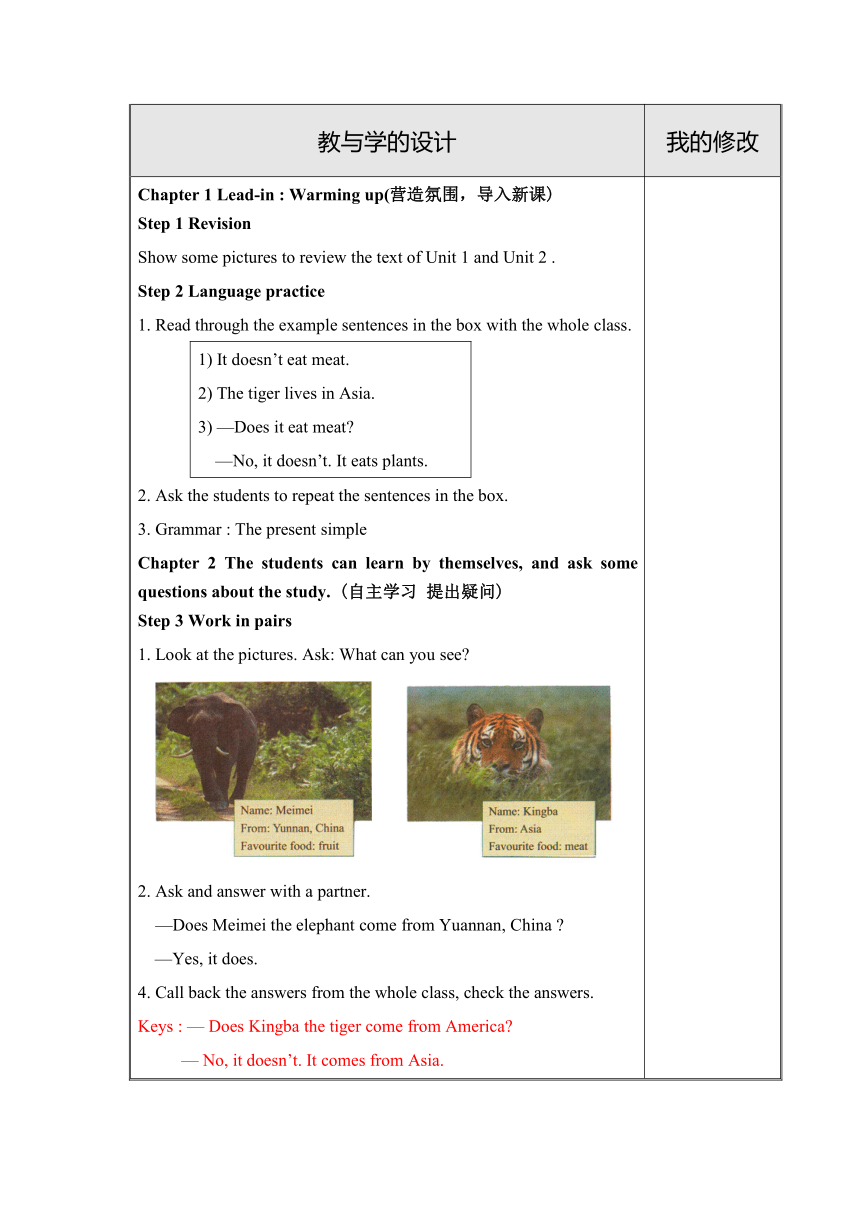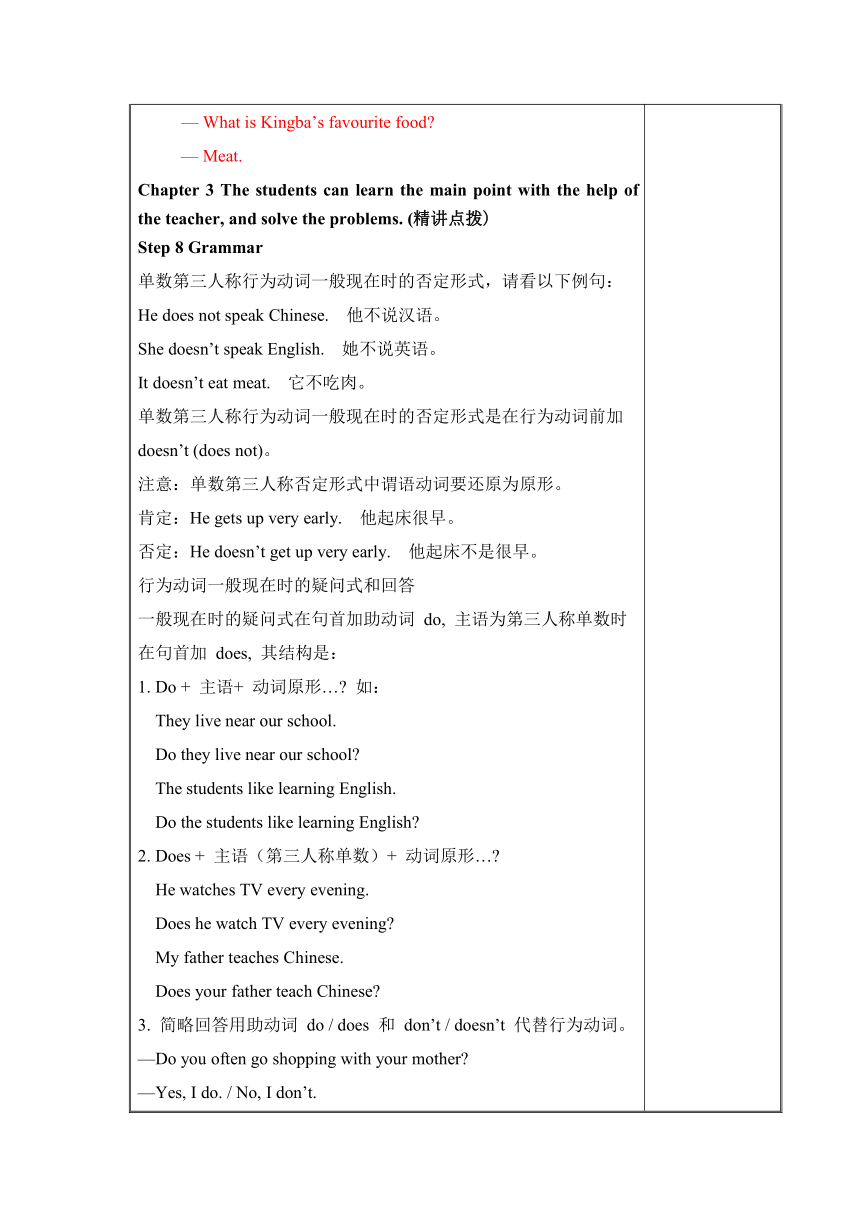Module 6 A trip to the zooUnit 3 Language in use.教案
文档属性
| 名称 | Module 6 A trip to the zooUnit 3 Language in use.教案 |  | |
| 格式 | zip | ||
| 文件大小 | 472.9KB | ||
| 资源类型 | 教案 | ||
| 版本资源 | 外研版 | ||
| 科目 | 英语 | ||
| 更新时间 | 2015-09-24 21:34:46 | ||
图片预览




文档简介
电子教案
年级:
学科:
教师:
课 题 Unit 3 Language in use 共 1课时
主备教师 使用教师
备课日期 上课日期
教材分析 教学目标 1. To summarise and consolidate Present simple questions.2. To know something about animals in China.3. To have teamwork and make a poster of one’s favourite animal
教学重难点 Key structures: It doesn’t eat meat.The tiger lives in Asia.Does it eat meat No, it doesn’t. It eats plants.
课 型 Revision and application 授课方法 Formal and interactive practice
教具准备 Tape recorder , OHP , handouts
教与学的设计 我的修改
Chapter 1 Lead-in : Warming up(营造氛围,导入新课)Step 1 RevisionShow some pictures to review the text of Unit 1 and Unit 2 .Step 2 Language practice1. Read through the ( http: / / www.21cnjy.com )example sentences in the box with the whole class.1) It doesn’t eat meat.2) The tiger lives in Asia.3) —Does it eat meat —No, it doesn’t. It eats plants.2. Ask the students to repeat the sentences in the box.3. Grammar : The present simpleChapter 2 The student ( http: / / www.21cnjy.com )s can learn by themselves, and ask some questions about the study. (自主学习 提出疑问)Step 3 Work in pairs1. Look at the pictures. Ask: What can you see ( http: / / www.21cnjy.com ) ( http: / / www.21cnjy.com )2. Ask and answer with a partner. —Does Meimei the elephant come from Yuannan, China —Yes, it does.4. Call back the answers from the whole class, check the answers.Keys : — Does Kingba the tiger come from America — No, it doesn’t. It comes from Asia.— What is Kingba’s favourite food — Meat.Chapter 3 The student ( http: / / www.21cnjy.com )s can learn the main point with the help of the teacher, and solve the problems. (精讲点拨)Step 8 Grammar单数第三人称行为动词一般现在时的否定形式,请看以下例句:He does not speak Chinese. 他不说汉语。She doesn’t speak English. 她不说英语。It doesn’t eat meat. 它不吃肉。单数第三人称行为动词一般现在时的否定形式是在行为动词前加doesn’t (does not)。注意:单数第三人称否定形式中谓语动词要还原为原形。肯定:He gets up very early. 他起床很早。否定:He doesn’t get up very early. 他起床不是很早。行为动词一般现在时的疑问式和回答一般现在时的疑问式在句首加助动词 do, 主语为第三人称单数时在句首加 does, 其结构是:1. Do + 主语+ 动词原形… 如: They live near our school. Do they live near our school The students like learning English. Do the students like learning English 2. Does + 主语(第三人称单数)+ 动词原形… He watches TV every evening. Does he watch TV every evening My father teaches Chinese. Does your father teach Chinese 3. 简略回答用助动词 do / does 和 don’t / doesn’t 代替行为动词。—Do you often go shopping with your mother —Yes, I do. / No, I don’t.—Does his mother work in that factory —Yes, she does. / No, she doesn’t.根据各题后括号内的要求完成下列各题。1) I like apples and bananas. (用Alice作主语改写句子) Alice _______ apples and bananas. 2) Mary does her homework at home. (改为否定句)Mary __________ her homework at home.3) Sam plays football after school every day. (改为一般疑问句并补全肯定回答)—______ Sam _______ football after school every day —Yes, _________.Keys: 1. likes 2. doesn’t do 3. Does; play; he doesChapter 4 Effective practice, consolidate the knowledge(训练巩固) Step 4 Complete the sentences with does or doesn’t. 1. Read through the sentences with the whole class.1)— _________ this panda come from China — Yes, it ________.2) — ________ this panda eat fish — No, it _______.3) — _________ this monkey like fruit — Yes, it ______.4) — ________ this monkey live in Africa — No, it ________. 5) The zebra _________ like meat.2. Ask the students to Complete the sentences with a partner.3. Call back the answers from the whole class, check the answers.Keys :1. Does, doe ( http: / / www.21cnjy.com )s 2. Does, does 3. Does, doesn’t 4. Does, doesn’t 5. doesn’tStep 5 Complete the ( http: / / www.21cnjy.com ) passage with the correct form of the words in the brackets.1. Read through the passage with the whole class.My favourite anim ( http: / / www.21cnjy.com )als (1) ____ ( be ) zebras. Look at this one ( 2). It ____ (be ) cute. It (3) _____ ( be ) black and white like the panda. But it (4) ________ ( do not ) come from Asia. It ( 5) _____ ( come ) from Africa. It ( 6) _____ ( eat ) grass.2. Ask the studen ( http: / / www.21cnjy.com )ts to fill in the blank individually, then check with a partner.3. Call back the answers from the whole class, check the answers.4. Read the passage together loudly.Keys :1. are 2. is 3. is 4. doesn’t 5. comes 6. eatsStep 6 Complete the word map with the words from the box. 1. Read through the words in the box with the whole class. ( http: / / www.21cnjy.com )2. Ask the students to ( http: / / www.21cnjy.com ) complete the word map with the words from the box with a partner.3. Call back the answers from the whole class, check the answers.Keys: Asia: panda monkey tiger elephantAmerica: monkeyAfrica: giraffe elephant zebra monkeyChapter 5 Summary evaluation, leak turnover(总结评价,查漏补缺)Step 7 Around the world: 1. Ask the st ( http: / / www.21cnjy.com )udents to look at the picture and discuss what they can see.The camel li ( http: / / www.21cnjy.com )ves in the deserts of Africa and Asia and eats grass. Some people think it carries water in the humps on its back, but it’s not true. In fact, it’s fat. ( http: / / www.21cnjy.com ) ( http: / / www.21cnjy.com )The kangaroo is an ( http: / / www.21cnjy.com )Australian animal. It eats grass and leaves, but it doesn’t eat meat. It carries its babies in a pocket on the front of its body. With its strong tail and back legs, the kangaroo jumps across the grassland.2. Read through the ( http: / / www.21cnjy.com ) information with the whole class, and talk something about them.Step 10 Module task: Making a poster of your favourite animal. 1. Work in groups. 1) Find out about an animal.2) Talk about your favourite animal.3) Choose one animal to write about4) Find out about the animalIt’s big/ small / tall, black and white /…It come fromAsia / Africa /…It eats meat / grass/ bamboo/…2. Make a poster about your group’s animal.1) Draw it or find a photo. 2) Write some information about it.3. Present your poster to the class.
作业布置 上网检索中国濒危动物的资料,并根据所查资料自制海报。运用所学表达方式,在海报中对该动物进行简单描述。
板书设计 Unit 3 Language in useIt doesn’t eat meat. The tiger lives in Asia. Does it eat meat No, it doesn’t. It eats plants.
课后反思
年级:
学科:
教师:
课 题 Unit 3 Language in use 共 1课时
主备教师 使用教师
备课日期 上课日期
教材分析 教学目标 1. To summarise and consolidate Present simple questions.2. To know something about animals in China.3. To have teamwork and make a poster of one’s favourite animal
教学重难点 Key structures: It doesn’t eat meat.The tiger lives in Asia.Does it eat meat No, it doesn’t. It eats plants.
课 型 Revision and application 授课方法 Formal and interactive practice
教具准备 Tape recorder , OHP , handouts
教与学的设计 我的修改
Chapter 1 Lead-in : Warming up(营造氛围,导入新课)Step 1 RevisionShow some pictures to review the text of Unit 1 and Unit 2 .Step 2 Language practice1. Read through the ( http: / / www.21cnjy.com )example sentences in the box with the whole class.1) It doesn’t eat meat.2) The tiger lives in Asia.3) —Does it eat meat —No, it doesn’t. It eats plants.2. Ask the students to repeat the sentences in the box.3. Grammar : The present simpleChapter 2 The student ( http: / / www.21cnjy.com )s can learn by themselves, and ask some questions about the study. (自主学习 提出疑问)Step 3 Work in pairs1. Look at the pictures. Ask: What can you see ( http: / / www.21cnjy.com ) ( http: / / www.21cnjy.com )2. Ask and answer with a partner. —Does Meimei the elephant come from Yuannan, China —Yes, it does.4. Call back the answers from the whole class, check the answers.Keys : — Does Kingba the tiger come from America — No, it doesn’t. It comes from Asia.— What is Kingba’s favourite food — Meat.Chapter 3 The student ( http: / / www.21cnjy.com )s can learn the main point with the help of the teacher, and solve the problems. (精讲点拨)Step 8 Grammar单数第三人称行为动词一般现在时的否定形式,请看以下例句:He does not speak Chinese. 他不说汉语。She doesn’t speak English. 她不说英语。It doesn’t eat meat. 它不吃肉。单数第三人称行为动词一般现在时的否定形式是在行为动词前加doesn’t (does not)。注意:单数第三人称否定形式中谓语动词要还原为原形。肯定:He gets up very early. 他起床很早。否定:He doesn’t get up very early. 他起床不是很早。行为动词一般现在时的疑问式和回答一般现在时的疑问式在句首加助动词 do, 主语为第三人称单数时在句首加 does, 其结构是:1. Do + 主语+ 动词原形… 如: They live near our school. Do they live near our school The students like learning English. Do the students like learning English 2. Does + 主语(第三人称单数)+ 动词原形… He watches TV every evening. Does he watch TV every evening My father teaches Chinese. Does your father teach Chinese 3. 简略回答用助动词 do / does 和 don’t / doesn’t 代替行为动词。—Do you often go shopping with your mother —Yes, I do. / No, I don’t.—Does his mother work in that factory —Yes, she does. / No, she doesn’t.根据各题后括号内的要求完成下列各题。1) I like apples and bananas. (用Alice作主语改写句子) Alice _______ apples and bananas. 2) Mary does her homework at home. (改为否定句)Mary __________ her homework at home.3) Sam plays football after school every day. (改为一般疑问句并补全肯定回答)—______ Sam _______ football after school every day —Yes, _________.Keys: 1. likes 2. doesn’t do 3. Does; play; he doesChapter 4 Effective practice, consolidate the knowledge(训练巩固) Step 4 Complete the sentences with does or doesn’t. 1. Read through the sentences with the whole class.1)— _________ this panda come from China — Yes, it ________.2) — ________ this panda eat fish — No, it _______.3) — _________ this monkey like fruit — Yes, it ______.4) — ________ this monkey live in Africa — No, it ________. 5) The zebra _________ like meat.2. Ask the students to Complete the sentences with a partner.3. Call back the answers from the whole class, check the answers.Keys :1. Does, doe ( http: / / www.21cnjy.com )s 2. Does, does 3. Does, doesn’t 4. Does, doesn’t 5. doesn’tStep 5 Complete the ( http: / / www.21cnjy.com ) passage with the correct form of the words in the brackets.1. Read through the passage with the whole class.My favourite anim ( http: / / www.21cnjy.com )als (1) ____ ( be ) zebras. Look at this one ( 2). It ____ (be ) cute. It (3) _____ ( be ) black and white like the panda. But it (4) ________ ( do not ) come from Asia. It ( 5) _____ ( come ) from Africa. It ( 6) _____ ( eat ) grass.2. Ask the studen ( http: / / www.21cnjy.com )ts to fill in the blank individually, then check with a partner.3. Call back the answers from the whole class, check the answers.4. Read the passage together loudly.Keys :1. are 2. is 3. is 4. doesn’t 5. comes 6. eatsStep 6 Complete the word map with the words from the box. 1. Read through the words in the box with the whole class. ( http: / / www.21cnjy.com )2. Ask the students to ( http: / / www.21cnjy.com ) complete the word map with the words from the box with a partner.3. Call back the answers from the whole class, check the answers.Keys: Asia: panda monkey tiger elephantAmerica: monkeyAfrica: giraffe elephant zebra monkeyChapter 5 Summary evaluation, leak turnover(总结评价,查漏补缺)Step 7 Around the world: 1. Ask the st ( http: / / www.21cnjy.com )udents to look at the picture and discuss what they can see.The camel li ( http: / / www.21cnjy.com )ves in the deserts of Africa and Asia and eats grass. Some people think it carries water in the humps on its back, but it’s not true. In fact, it’s fat. ( http: / / www.21cnjy.com ) ( http: / / www.21cnjy.com )The kangaroo is an ( http: / / www.21cnjy.com )Australian animal. It eats grass and leaves, but it doesn’t eat meat. It carries its babies in a pocket on the front of its body. With its strong tail and back legs, the kangaroo jumps across the grassland.2. Read through the ( http: / / www.21cnjy.com ) information with the whole class, and talk something about them.Step 10 Module task: Making a poster of your favourite animal. 1. Work in groups. 1) Find out about an animal.2) Talk about your favourite animal.3) Choose one animal to write about4) Find out about the animalIt’s big/ small / tall, black and white /…It come fromAsia / Africa /…It eats meat / grass/ bamboo/…2. Make a poster about your group’s animal.1) Draw it or find a photo. 2) Write some information about it.3. Present your poster to the class.
作业布置 上网检索中国濒危动物的资料,并根据所查资料自制海报。运用所学表达方式,在海报中对该动物进行简单描述。
板书设计 Unit 3 Language in useIt doesn’t eat meat. The tiger lives in Asia. Does it eat meat No, it doesn’t. It eats plants.
课后反思
同课章节目录
- Starte
- Module 1 My teacher and my friends
- Module 2 My English lesson
- Module 3 My English book
- Module 4 My everyday life
- Module 1 My classmates
- Unit 1 Nice to meet you.
- Unit 2 I'm Wang Lingling and I'm thirteen years ol
- Unit 3 Language in use.
- Module 2 My family
- Unit 1 Is this your mum?
- Unit 2 These are my parents.
- Unit 3 Language in use.
- Module 3 My school
- Unit 1 There are thirty students in my class.
- Unit 2 The library is on the left of the playgroun
- Unit 3 Language in use.
- Module 4 Healthy food
- Unit 1 We've got lots of apples.
- Unit 2 Is your food and drink healthy?
- Unit 3 Language in use.
- Module 5 My school day
- Unit 1 I love history.
- Unit 2 We start work at nine o'clock.
- Unit 3 Language in use.
- Revision module A
- Module 6 A trip to the zoo
- Unit 1 Does it eat meat?
- Unit 2 The tiger lives in Asia.
- Unit 3 Language in use.
- Module 7 Computers
- Unit 1 How do I write my homework on the computer?
- Unit 2 When do you use a computer?
- Unit 3 Language in use.
- Module 8 Choosing presents
- Unit 1 I always like birthday parties.
- Unit 2 She often goes to concerts.
- Unit 3 Language in use.
- Module 9 People and places
- Unit 1 We're enjoying the school trip a lot.
- Unit 2 They're waiting for buses or trains.
- Unit 3 Language in use.
- Module 10 Spring Festival
- Unit 1 Are you getting ready for Spring Festival?
- Unit 2 My mother's cleaning our houses and sweepin
- Unit 3 Language in use.
- Revision module B
